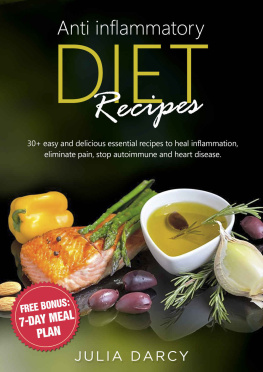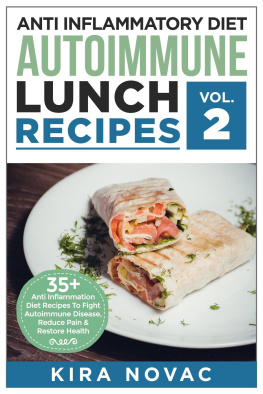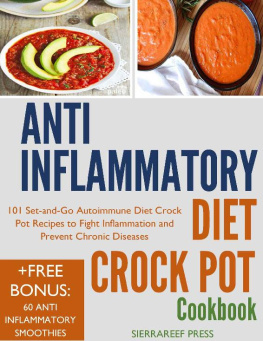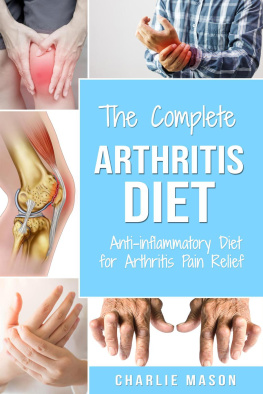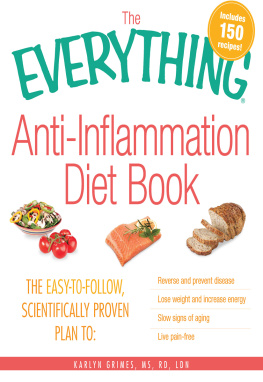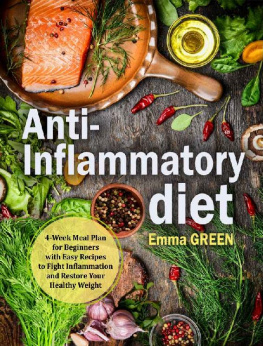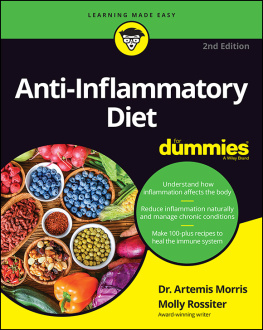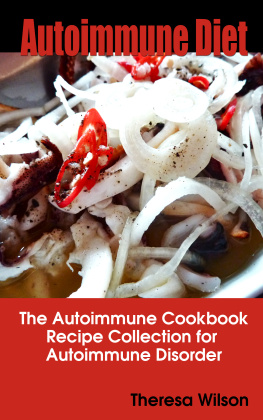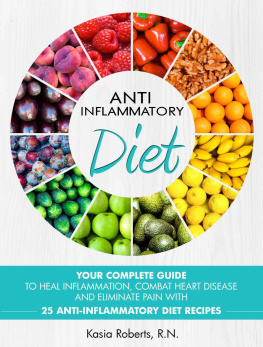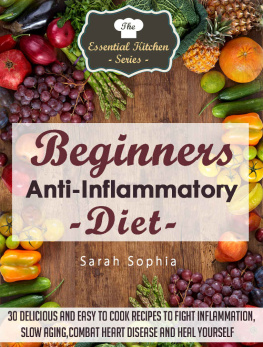Anti-Inflammatory Diet Recipes
30+ easy and delicious essential recipes to heal
inflammation, eliminate pain, stop autoimmune
and heart disease.
By Julia Darcy
Copyright 2015
Copyright 2015 by Julia Darcy
All rights reserved. No part of this publication may be reproduced, stored in retrieval system, or transmitted, in any form or by any means, electronic, mechanical, photocopying, recording, or otherwise without the prior written permission of author.
Disclaimer
This book was designed to guide individuals and is not meant to replace the work of a professional therapist, counselor or physician.
This book is for educational purposes only. The author and publisher shall have neither liability nor responsibility to any person or entity with respect to any loss or damage caused or alleged to be caused directly or indirectly by the information contained in this book.
ISBN: 978-0-9947683-2-2
Introduction
Lets start by explaining what inflammation is. Inflammation is simply a protective process, where the body defends itself from harmful pathogens and triggers including irritants, damaged cells and other triggers. Inflammation should not be confused with infection Infection causes inflammation which is the bodys response towards removing the infection.
What causes inflammation and pain?
Inflammation is a natural biological process that allows the body to heal and regenerate itself in situations of injury and it occurs in different stages. Commonly mistaken as the entire inflammatory response, Irritation is simply the first phase Irritants are triggers that cause the immune system to react in such a way that this trigger is removed from the body. This essential process is required for healing of tissues on the organ level, and the body on the whole. In everyday life, there are several triggers that initiate a response of the immune system.
In cases of allergies, a common example of inflammatory response, the trigger material causes a reaction during which the body secretes a large amount of defensive material the White Blood Cells (WBC), which ingest the foreign material and excrete them from the body. When this is carried out, there is a side effect to it all the inflammatory response. This response causes localized swelling, redness, and a bit of pain.
Under normal circumstances, inflammation is for a short duration, where the effects are reduced as soon as the trigger material is removed called acute inflammation. Sometimes, the inflammation can be for a much longer duration where the initial inflammation is actually responsible for further secondary inflammation this condition is called chronic inflammation and is characterized by long durations of irritation in the tissues as well as swelling, redness and severe discomfort to the body. Chronic Inflammation is the condition where the irritant remains within the body and cannot be removed, or in certain situations, where the body itself thinks that the tissue where this inflammation has occurred is foreign material. In this situation, the body gives out a blown up immune response that damages tissues and organs severely to a point of disabling a person.
During an inflammatory response, we feel pain, discomfort, stiffness and a bit of all-out-agony. This pain is often a constant, throbbing or pulsing type which can also be a pinching or stabbing type of pain.
There are different kinds of pain, all of which share a common origin the swelling of the tissue in response to the inflammation pushes against sensitive nerve endings which then send pain signals to the brain. While nerve cells are constantly sending signals to the brain during normal, healthy situations, the brain recognizes these as not important and ignores them. However, when the pressure on these nerves increases, the brain recognizes these signals and translates into what we feel as pain.
Disease where inflammation occurs
Constant inflammation of tissues within the body causes chronic inflammation a highly dangerous situation where the body mistakes its own tissues to be foreign material or triggers, and beings a minor or major attack on itself via the White Blood Cells.
This is a highly dangerous situation as the body begins a fight with itself and starts to damage and kill healthy tissue. This type of disease is called an autoimmune disease and includes several diseases and disorders which can be fatal Lupus, Celiac disease, Addisons, Huntingtons, Vasculitis, Arthritis and even Alzheimers; to name a few.
How to test for inflammation:
While it is easy to check for acute inflammation because of the obvious irritation, swelling and pain, sometimes it becomes difficult during chronic inflammation, to identify what exactly is happening in the body as there are no external signs, just a deep pain that causes severe discomfort. The simplest way is usually through a blood test where an important marker the C Reactive Protein is checked for along with the levels of WBCs.
- Blood test C - reactive protein: C - reactive protein or CRP is the best method to detect inflammation. During an infection and the resulting inflammation, the levels of CRP in the body become increased. When it exceeds a minimal amount that is an indication that your body is becoming increasingly damaged from the inside and can be easily affected by disorders and diseases.
According to the Center for Disease Control (CDC), a CRP level of less than 1.0 mg/L is a low risk for heart conditions. Moderate risk is indicated by a level between 1.0 and 3.0 mg/L, and anything over 3.0mg/L is an obvious high risk indicator for heart disease. A CRP blood level of over 10mg/L indicates a strong possibility of inflammatory disease and even a damaged immune system.
Inflammatory triggers : what not to eat
As discussed earlier, sometimes the food we eat can be a trigger that causes a rapid inflammatory attack. Examples of this include regular food allergies such as nut, seafood, soy allergies, and also gluten and lactose (milk) intolerance. These foods cause the body to react in a manner that is similar to an infection, and makes the body think that it is under attack.
The body immediately mounts a response, observed as an inflammatory reaction that tries to remove this allergy causing substance(s) from the body.
Its not always possible to keep track of what we consume; however, we can always try to make sure that we control our diet to avoid these triggers, for healthier lives.
Why choose an anti-inflammatory diet?
While chronic inflammation can be caused by a wide variety of factors including stress, tobacco smoke, exposure to toxins and triggers; dietary choices play an equally big role in inflammation too. Excessive consumption of processed foods has caused a major increase in inflammatory diseases and disorders.
An Anti Inflammatory diet (AID) is not a diet as such, at least not in the popular sense where you go on it to lose weight. This diet is more a means of having the knowledge and will to prepare foods in a scientific manner that allows your body to maintain the best of health. This does have the added advantage of helping you lose excess weight and getting into proper shape.
An AID has the primary aim of reducing inflammation of course, along with providing your body with a steady supply of energy, vitamins and minerals along with all the other essentials including fiber, fatty acids and other nutrients; such that your body is at its peak. The diet allows a wide variety of foods that are as fresh as possible. The diet also cuts down on the amount of junk and processed food that is eaten and increases a fruit and vegetable intake to supplement the growth and healing of the body.

